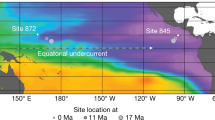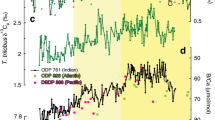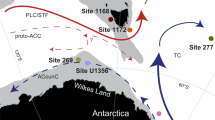Abstract
The middle of the Cretaceous period (about 120 to 80 Myr ago) was a time of unusually warm polar temperatures1, repeated reef-drowning in the tropics2 and a series of oceanic anoxic events (OAEs) that promoted both the widespread deposition of organic-carbon-rich marine sediments and high biological turnover3,4,5,6,7,8. The cause of the warm temperatures is unproven but widely attributed to high levels of atmospheric greenhouse gases such as carbon dioxide7,8,9,10,11,12. In contrast, there is no consensus on the climatic causes and effects of the OAEs, with both high biological productivity and ocean ‘stagnation’ being invoked as the cause of ocean anoxia3,4,5,6,7,8. Here we show, using stable isotope records from multiple species of well-preserved foraminifera, that the thermal structure of surface waters in the western tropical Atlantic Ocean underwent pronounced variability about 100 Myr ago, with maximum sea surface temperatures 3–5 °C warmer than today. This variability culminated in a collapse of upper-ocean stratification during OAE-1d (the ‘Breistroffer’ event), a globally significant period of organic-carbon burial that we show to have fundamental, stratigraphically valuable, geochemical similarities to the main OAEs of the Mesozoic era. Our records are consistent with greenhouse forcing being responsible for the warm temperatures, but are inconsistent both with explanations for OAEs based on ocean stagnation, and with the traditional view (reviewed in ref. 12) that past warm periods were more stable than today's climate.
This is a preview of subscription content, access via your institution
Access options
Subscribe to this journal
Receive 51 print issues and online access
$199.00 per year
only $3.90 per issue
Buy this article
- Purchase on Springer Link
- Instant access to full article PDF
Prices may be subject to local taxes which are calculated during checkout



Similar content being viewed by others
References
Fischer, A. G. in Climate in Earth History (ed. Berger, W.) 97–104 (National Academy of Sciences, Washington DC, 1982).
Wilson, P. A., Jenkyns, H. C., Elderfield, H. & Larson, R. L. The paradox of drowned carbonate platforms and the origin of Cretaceous guyots. Nature 392, 889–894 (1998).
Jenkyns, H. C. Cretaceous anoxic events: from continents to oceans. J. Geol. Soc. Lond. 137, 171–188 (1980).
Herbert, T. D. & Fischer, A. G. Milankovitch climatic origin of mid-Cretaceous black shale rhythms in central Italy. Nature 321, 739–743 (1986).
Arthur, M. A., Dean, W. E. & Pratt, L. M. Geochemical and climatic effects of increased marine organic carbon burial at the Cenomanian/Turonian boundary. Nature 335, 714–717 (1988).
Arthur, M. A., Jenkyns, H. C., Brumsack, H. & Schlanger, S. O. in Cretaceous Resources, Events and Rhythms (eds Ginsburg, R. N. & Beaudoin, B.) 75–119 (NATO ASI Series C, 304, Kluwer Academic, Dordrecht, 1990).
Schlanger, S. O., Jenykns, H. C. & Premoli-Silva, I. Volcanism and vertical tectonics in the Pacific basin related to global Cretaceous transgressions. Earth Planet. Sci. Lett. 52, 435–449 (1981).
Arthur, M. A., Dean, W. E. & Schlanger, S. O. in The Carbon Cycle and Atmospheric CO2: Natural Variations Archean to Present (eds Sundquist, E. T. & Broecker, W. S.) 504–529 (AGU Monograph 32, American Geophysical Union, Washington DC, 1985).
Barron, E. J. & Washington, W. M. in The Carbon Cycle and Atmospheric CO2: Natural Variations Archean to Present (eds Sundquist, E. T. & Broecker, W. S.) 546–553 (AGU Monograph 32, American Geophysical Union, Washington DC, 1985).
Manabe, S. & Bryan, K. CO2-induced change in a coupled ocean-atmosphere model and its palaeoclimatic implications. J. Geophys. Res. 90, 11689–11708 (1985).
Crowley, T. J. Past CO2 changes and tropical sea surface temperatures. Paleoceanography 6, 387–394 (1991).
Barron, E. in Effects of Past Global Change on Life 108–117 (Studies in Geophysics, National Academy Press, Washington DC, 1995).
Huber, B. T., Hodell, D. A. & Hamilton, C. P. Middle-Late cretaceous climate of southern high latitudes: stable isotopic evidence for minimal equatorial-to-pole thermal gradients. Geol. Soc. Am. Bull. 107, 1164–1191 (1995).
Wilson, P. A. & Opdyke, B. N. Equatorial sea surface temperatures for the Maastrichtian revealed through remarkable preservation of metastable carbonate. Geology 24, 555–558 (1996).
Norris, R. D. & Wilson, P. A. Low latitude sea surface temperatures for the mid-Cretaceous and the evolution of planktonic foraminifera. Geology 26, 823–826 (1998).
Erbacher, J. & Thurow, J. Influence of oceanic anoxic events on the evolution of mid-Cretaceous radiolaria in the North Atlantic and western Tethys. Mar. Micropaleontol. 30, 139–158 (1997).
Erbacher, R. D., Huber, B. T., Norris, R. D. & Markey, M. Increased thermohaline stratification as a possible cause for a Cretaceous oceanic anoxic event. Nature 409, 325–327 (2001).
Erba, E. et al. Integrated stratigraphy of the Cismon Apticore (Southern Alps, Italy): “A reference section” for the Barremian-Aptian interval at low latitudes. J. Foram. Res. 29, 371–391 (1999).
Opdyke, B. N., Erba, E. & Larson, R. L. Hot LIPs and mantle methane. Eos 80, F486–F487 (1999).
Hesselbo, S. P. Massive dissociation of gas hydrate during a Jurassic oceanic anoxic event. Nature 406, 392–395 (2000).
Shipboard Scientific Party . Explanatory notes. Proc. ODP Init. Rep. 144, 20 (1995).
Crowley, T. J. & Zachos, J. C. in Warm Climates in Earth History (eds Huber, B. T., MacLeod, K. G. & Wing, S. L.) 50–76 (Cambridge Univ. Press, Cambridge, 2000).
Sarmiento, J. L., Herbert, T. D. & Toggweiler, J. R. Causes of anoxia in the world ocean. Glob. Biogeochem. Cycles 2, 115–128 (1988).
Wolff, T., Mulitza, S., Ruhlemann, C. & Wefer, G. Response of the tropical Atlantic thermocline to late Quaternary trade wind changes. Palaeoceanography 14, 374–383 (1999).
Gale, A. S., Kennedy, W. J., Burnett, J. A., Caron, M. & Kidd, B. E. The late Albian to Early Cenomanian succession at Mont Risou near Rosans (Drome, SE France): an integrated study (ammonites, inoceramids, planktonic foraminifera, nannofossils, oxygen and carbon isotopes. Cret. Res. 17, 515–606 (1996).
Stoll, H. M. & Schrag, D. P. High-resolution stable isotope records from the Upper Cretaceous rocks of Italy and Spain: Glacial episodes in a greenhouse planet? Geol. Soc. Am. Bull. 112, 308–319 (2000).
Smith, A. G., Smith, D. G. & Funnell, B. M. Atlas of Mesozoic and Cenozoic Coastlines (Cambridge Univ. Press, Cambridge, 1994).
Hofmann, P., Ricken, W., Schwark, R. L. & Leythaeuser, D. Carbon-sulfur-iron relationships in δ13C of organic matter from late Albian sedimentary rocks from the North Atlantic Ocean: palaeoceanographic implications. Palaeogeogr. Palaeoclimatol. Palaeoecol. 163, 97–113 (2000).
Bemis, B. E., Spero, H. J., Bijma, J. & Lea, D. W. Reevaluation of the oxygen isotopic composition of planktonic foraminifera: Experimental results and revised palaeotemperature equations. Palaeoceanography 13, 150–160 (1998).
Poulsen, C. J., Barron, E. J., Peterson, W. H. & Wilson, P. A. A reinterpretation of mid-Cretaceous shallow-marine temperatures through model-data comparison. Palaeoceanography 14, 679–697 (1999).
Acknowledgements
We thank M. Cooper, M. Hall and K. Davis for laboratory assistance and manuscript production; M. Arthur and E. Barron for comments on the manuscript; and D. Kroon, H. Elderfield, J. Erbacher, B. Huber, L. Kump, B. Opdyke, C. Poulsen, G. Ravizza, E. Rohling and N. Shackleton for support and discussions. This work was supported by a NERC post-doctoral research fellowship and a UK ODP rapid response grant.
Author information
Authors and Affiliations
Corresponding author
Rights and permissions
About this article
Cite this article
Wilson, P., Norris, R. Warm tropical ocean surface and global anoxia during the mid-Cretaceous period. Nature 412, 425–429 (2001). https://doi.org/10.1038/35086553
Received:
Accepted:
Issue Date:
DOI: https://doi.org/10.1038/35086553
This article is cited by
-
Rapid grain boundary diffusion in foraminifera tests biases paleotemperature records
Communications Earth & Environment (2023)
-
Ancient fish lineages illuminate toll-like receptor diversification in early vertebrate evolution
Immunogenetics (2023)
-
Chemo- and biostratigraphy of the Cretaceous Dalmiapuram Formation, Uttatur Group, Kallakudi II section, Cauvery Basin, South India
Arabian Journal of Geosciences (2021)
-
Methane-derived carbonate formation triggered by the latest Albian anoxia in northwestern Tunisia basins
Arabian Journal of Geosciences (2020)
-
Carbon cycle instability and orbital forcing during the Middle Eocene Climatic Optimum
Scientific Reports (2019)
Comments
By submitting a comment you agree to abide by our Terms and Community Guidelines. If you find something abusive or that does not comply with our terms or guidelines please flag it as inappropriate.



